
Tires play a critical role in improving mileage
By Don Darden
There is a tendency to think bus and coach fleets generally do not run fuel efficient, that operating a fleet of buses by nature is a high fuel-consumption vocation and there is just not much anyone can do about it.
Well, here’s some good news. The worse the fuel economy the more the operator has to gain from taking steps to improve the situation. Bus and coach owners will find they can parlay small improvements into big wins.
Where the fuel goes
Because of basic energy losses in the engine and drive train, only about half the fuel consumed actually ends up moving the vehicles down the road. Of that, here’s where that fuel goes:
Six tire-related factors that guzzle fuel
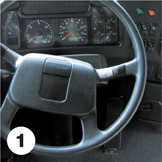 1. Driving habits
1. Driving habits
Speed is one of the biggest factors of poor fuel economy and is largely the result of careless driver habits. Running at high speeds on intercity bus routes guzzles fuel, but so do jackrabbit starts and hammer-down runs between stops in city driving, which also burn up brakes. Driver education and incentives can be very effective in reducing fuel consumption.
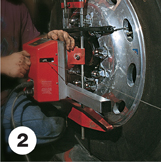 2. Tire alignment
2. Tire alignment
Tires need to point straight ahead in order to roll with the least possible resistance. Misaligned tires scrub as they turn, which can cut tire life by as much as 20 percent.
What’s more, an axle misalignment of just 2.5 degrees can cause enough drag to increase fuel consumption by 16 percent. That’s huge, and something you can correct with an effective vehicle maintenance program.
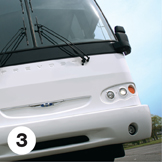 3. Vehicle aerodynamics
3. Vehicle aerodynamics
Buses and motorcoaches are not the most aerodynamic vehicles on the highway. As with speed, fuel consumption lost to wind resistance gets much worse at higher speeds. At 55 mph about half of the fuel that turns the wheels is used up pushing against air. At 65 mph it is nearly two-thirds of the available fuel energy. Just about any measure a company can take to make buses to improve performance due to aerodynamics and wind resistance will pay off in fuel savings.
 4. Vehicle maintenance
4. Vehicle maintenance
Alignment isn’t the only vehicle maintenance item that affects fuel economy. Here are some others:
Maintenance tips for fuel economy
Check and maintain fluid levels regularly
Check for and repair any fuel or
fluid leaks
Replace filters regularly
Record and track maintenance calls and work
 5. Tire maintenance
5. Tire maintenance
Tires do not carry the load of the buses; the air inside the tires does the job. Proper inflation is vital to maintain proper stress distribution and to reduce the flexing and heat build-up that wastes fuel. Heat build-up causes tires to wear faster and accelerates the aging process. Improper inflation reduces the traction, making tires a safety hazard. Under inflation wastes fuel, wearing out tires prematurely and reducing their retreadability.

Inflation pressure effect on fuel economy
Bridgestone Mileage Sales recommends a program to reduce all of these losses by ensuring proper tire inflation:
Check and adjust inflation pressure regularly (when a vehicle has been parked at least three hours and before it has been driven more than one mile).
Adjust inflation pressures to meet vehicle and tire requirements.
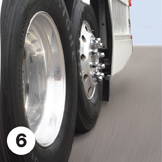 6. Select fuel-efficient tires and retreads
6. Select fuel-efficient tires and retreads
The tires manufactured especially for buses can also have a big effect on fuel consumption. Today there are a wide variety of low-rolling resistance new tires and retreads available that can save you fuel.
Tire rolling resistance
Rolling resistance is the force required to roll a tire under load. It can affect total fuel consumption by 9 to 13 percent. With today’s fuel prices, that’s very important.
Between 35 and 50 percent of a tire’s rolling resistance is a function of its tread. Tread design and rubber compounding both contribute to fuel efficiency.
 As tires wear they become more fuel efficient. They weigh less and shallower tread elements tend to squirm less, which reduces fuel-wasting heat losses and slows overall tread wear. Bridgestone Mileage Sales offers several new tire options with excellent rolling resistance for both intra- and intercity buses, and can also provide you with Bandag FuelTech® retreads, which combine the low cost of retreads with the fuel economy of the best new tires.
As tires wear they become more fuel efficient. They weigh less and shallower tread elements tend to squirm less, which reduces fuel-wasting heat losses and slows overall tread wear. Bridgestone Mileage Sales offers several new tire options with excellent rolling resistance for both intra- and intercity buses, and can also provide you with Bandag FuelTech® retreads, which combine the low cost of retreads with the fuel economy of the best new tires.
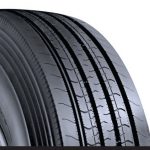 Bridgestone R249 All-Position Radial
Bridgestone R249 All-Position Radial
Fuel-efficient, with excellent wet handling and braking
Smooth, even wear from optimized crown and footprint shape
Cut- and chip-resistant
compound fights damage
Superior driver and passenger comfort from even wear and low noise
Low-rolling resistance for excellent fuel economy
Long tread life from larger footprint
Smooth, even wear from asymmetric blocks and shoulder tie-bars
Outstanding wet traction and
handling
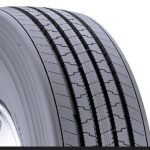 Firestone FS400 All-Position Radial
Firestone FS400 All-Position Radial
Specially designed for heavy loads in intercity bus service
Shoulder wear protector grooves minimize step-down wear
Stone rejector platforms fight retention of casing-damaging stones
Groove fences and computer-
designed features for quieter ride
 Firestone FD600 Drive Radial
Firestone FD600 Drive Radial
Aggressive, open shoulder design for superior traction
Individual traction blocks with
multiple edges for wet handling
Straight tread grooves for efficient water evacuation
Two-ply nylon plus one steel chafer for superior bead durability BR

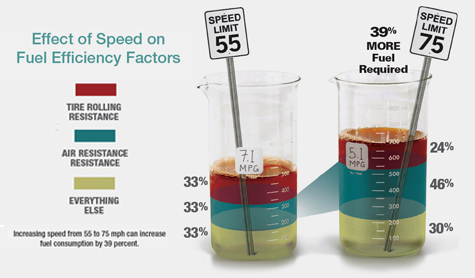
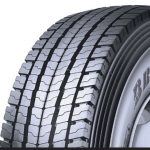
In my experience at Squarerigger while developing Revolution®, I found few bus fleets have the staff to maintain a 100% daily (or even weekly) check of tire condition, pressure and tread depth and also record the information in a spreadsheet or computer system. Many of our contacts say they average between 8 and 20 minutes to complete the task of inspecting tires on a single bus, and get that data into a spreadsheet or system. Getting reports out is another matter, and spreadsheet reports are limited in value.
There are a number of tire management systems, but they have big differences. Those differences can open or close doors to improved maintenance practices. Some are tied to a computer in an office. Some are portable, but slow. Some are portable and fast.
If you could inspect one bus every other minute and spot a few problems you could schedule to fix, would you inspect them all in the shop or out in the yard? If a well-trained high school senior could inspect 100 buses in the yard in four hours, would you do it daily? If the reports produced prioritized work that needed to be done ASAP, do you have the ability to jump on the few critical ones and get them done before they become real problems?
Before embarking on a quest for the perfect process, look to your own maintenance limitations and practices and ask yourself why they exist. Sometimes we do things the way we do simply because it works, or because we just do not have the staff to do more. Tire tracking systems can absorb resources you do not have — or can free them up, depending on your own circumstances. Take your time to evaluate the alternatives. The system you choose must free up resources, reduce total costs and lower safety and liability risks.